“CORK AND WOODEN STEINS”
(Also please see: “THE PEG TANKARDS’” on Page 3.)
Some of the most misunderstood and least written about beer steins are those made of wood or mostly wood; sometimes called “treen”. All European countries made them, from one of the earliest, (recorded in England in A.D. 960) up to today’s cheap city and place souvenirs. John Stuart, our departed friend and SCI Master Steinologist used to lecture on beer steins and other drinking vessels made out of natural materials. John would talk about ivory, horns, eggs, coconut, and marble steins just to mention a few. So I was very excited after I spotted the stein (shown just below ▼) several years back on a fellow stein collector’s “for sale” table and realized what it was made from. At first glance it appeares to be made of wood, but upon further examination I found out it was not wood per se, but a wood product; which at the time I knew nothing about. It was made of ‘cork! John’s collection did not include any ‘cork’ pieces, so this will be my small contribution to the knowledge of drinking vessels made from natural materials.
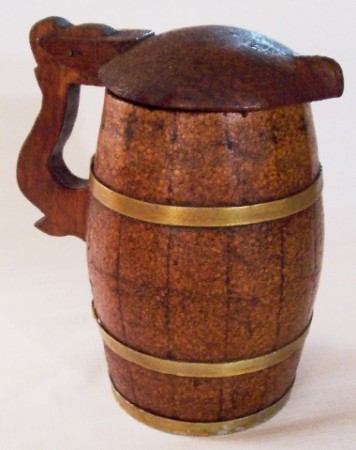
The cork and wood stein in a barrel form: All of the staves are still intact and most are tight one to another, even after years of heavy usage. Height is 9 inches. Diameter at base: 6.5 inches. One brass band is missing. Circa 1900. [FWTD]
![1R CORK ARTICLE [2]](http://www.steveonsteins.com/wp-content/uploads/2010/08/1R-CORK-ARTICLE-2.jpg)
Shown: The “turned” wooden lid and the pitched inside indicating it was a “drinking vessel” and not used for carrying grain, sugar, etc. I have not been able to pinpoint the exact country of origin as there are no markings and I have never seen another referenced anywhere. The indication to me, due to its ‘pointed-front’ (beaked) lid, is that it probably was made in Germany either along the Rhine River where ‘Cork’ is abundantly imported and used within their massive wine industry, OR, in Bavaria at or for a big wine Rathskeller. (See the other examples of “Beaked lids”, on steins on page 3 of this series.) (While some SCI members might think this is heresy; I would fathom a guess that about 4 to 5% of all of what we call beer steins were in fact made for drinking wine! )
Below . lower end or rather common wooden pieces:
Above ▲: A very typical all wooden stein made of cut staved and bound by cut willows. These were made in all European countries, with some VERY FEW late 1600’s examples still being found. Most found however will have been made in the period of the late 1700’s to the early 1900’s. Some Scandinavian countries are now selling newer versions of old steins done in wood in the old manner. The one above is a typical alternating colors staved stein, probably from around the “Austro-Hungarian area – mid 1800’s. A very nicely preserved finish is on this one.
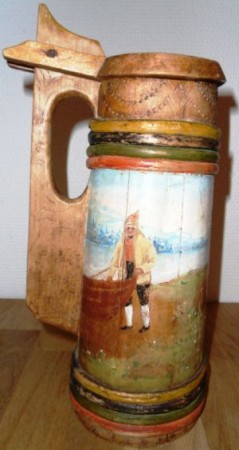
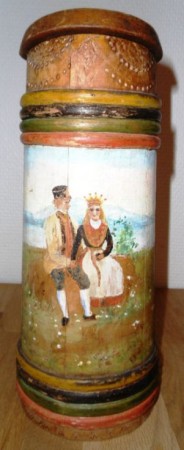
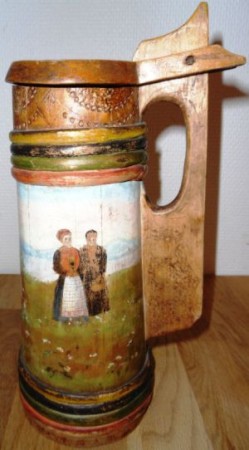
Above: Sweden. Circa early 1900’s, hand painted folk art, 10.8 inch.
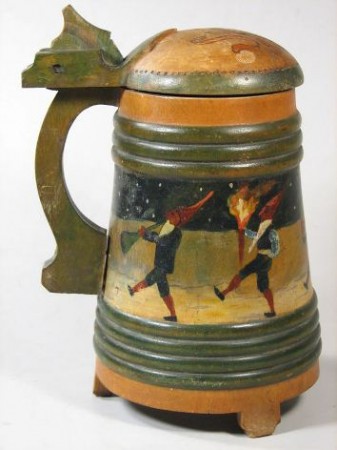
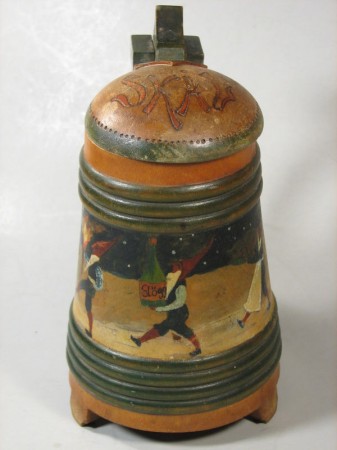
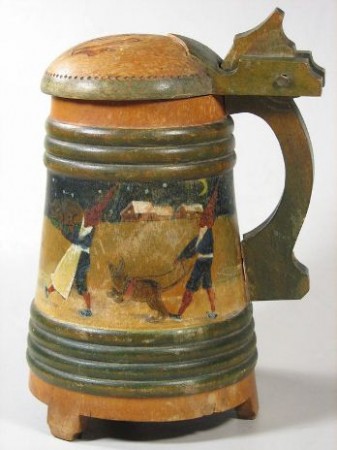
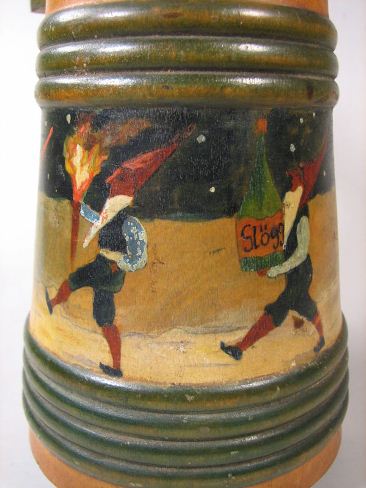
Detail a very interesting little piece of folk art. Scratch Marked “Stockholm,” not dated, but around 1890- 1910 I think. Hand painted. 6.5 inch – A New Year’s gnome parade. The champagne bottle is half as big as the carrier. [FWTD]
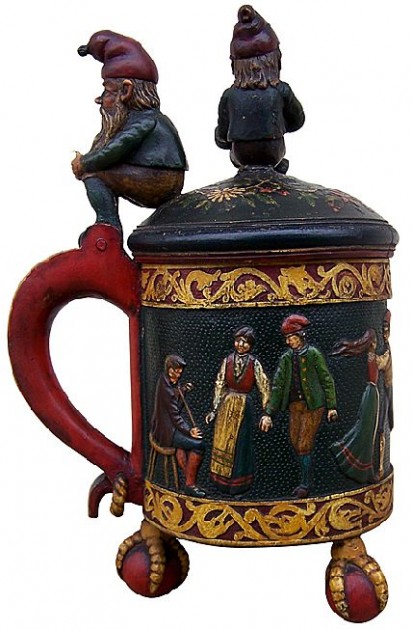
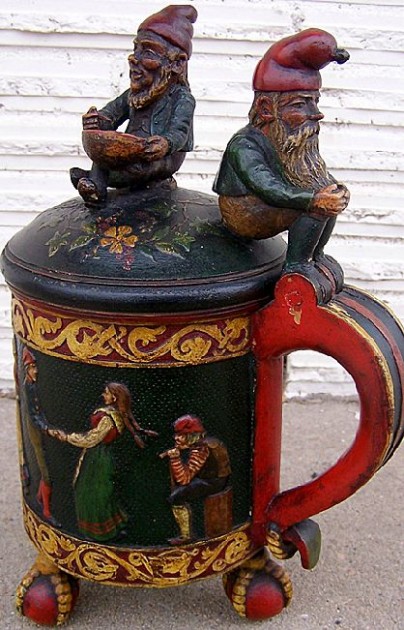
A large = 13.5 inches tall [x] 5.45 inches wide, hand carved and painted Scandinavian wooden tankard with “ball and claw” feet. This is not a “peg” tankard. Carved body figures with a “reverse stippled” background. I’ll SWAG this to be Circa 1850. The large gnome as the thumblift may be representative of “The Scandinavian gnome king: Andvari.” Excellent condition. (Comps of J. Johnson = “Mr. Lucky”.)
![WOODEN salvageable [q] serg has at $185.00 10-11](http://www.steveonsteins.com/wp-content/uploads/2010/06/WOODEN-salvageable-q-serg-has-at-185.00-10-11-325x630.jpg)
An Eastern European variant. This one has steel straps and pins. It comes with a very nicely carved lid and thumblift. A shame someone didn’t take care of it = very hard to restore that bent stave. I’m thinking Circa 1860.
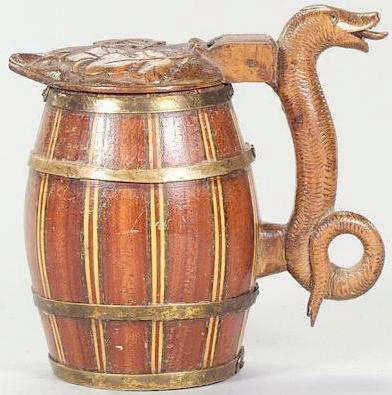
A Slovakian wooden staved stein. Circa 1850-80. These are most often called Scandinavian, but the often elaborate carved handles, the alternating multi-colored wooden staves used and the brass bands are the indicators of that these were Czech / Slovakian made.
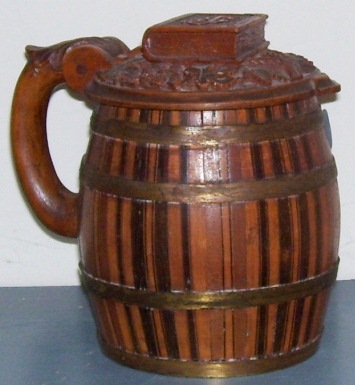
Here’s another nice example of Austro-Hungarian alternating colored staves work, with a book carved as the lid’s center piece/ finial . Ca. 1860-80. [JS]
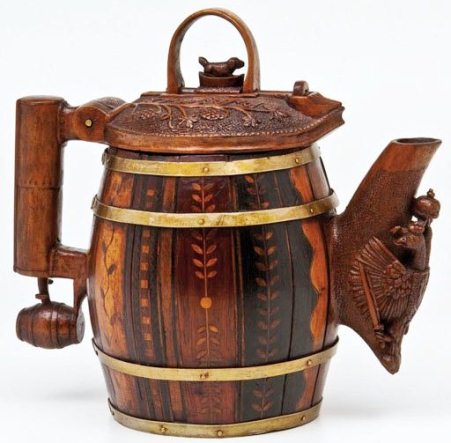
An even nicer and more ornate staved serving jug from Austria -Hungry. Ca. 1880. The incised alternating colors on the staves is very seldom seen. Check out what’s hanging under the handle.
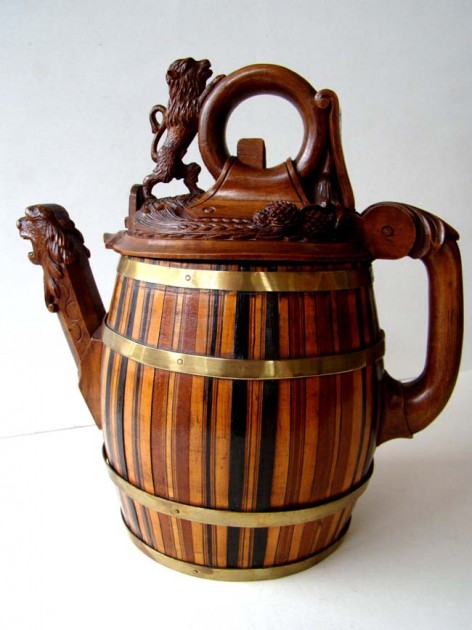
Even nicer than the “even nicer” one just above!
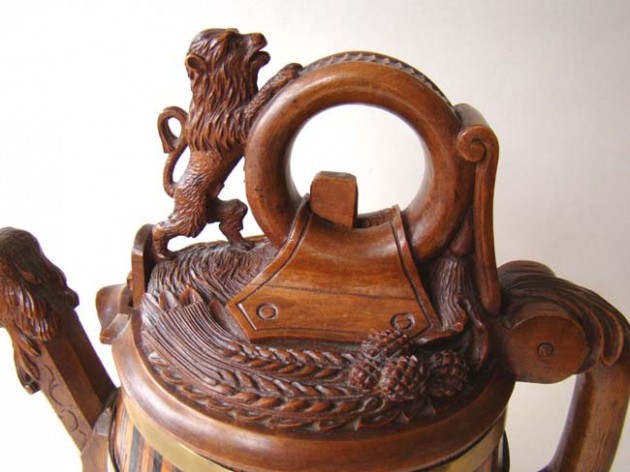
Detail of the excellent carving on the “Lock top” lid. Height 10.75 inch. Width 10 in. Austria -Hungry. Ca. 1880.
(Both photos courtesy of original seller: Richard Kahn, and its present owner, Christopher Louis.)
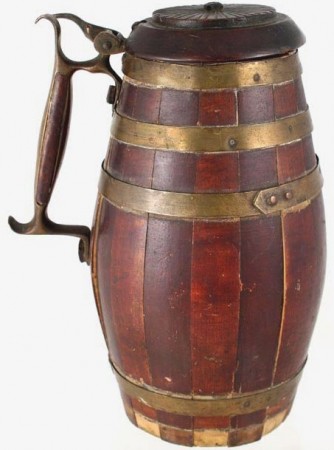
Above: Wooden staved stein made in the Ukraine (which borders Slovakia – please see other wooden staved example just above.) Circa 1850. Many of these have embedded materials in the handle and a very unique thumb-lift arrangement where the thumb-lift slides to the side of the handle attachment. See this thumblift attachment also on the City of Kiev bronze stein example on: http://www.steveonsteins.com/not-your-average-stein-1-2
Old wooden staved stein. Probably Austrian. Circa 1860, with a Baker’s occupational “pretzel” pewter thumblift; very unusual.
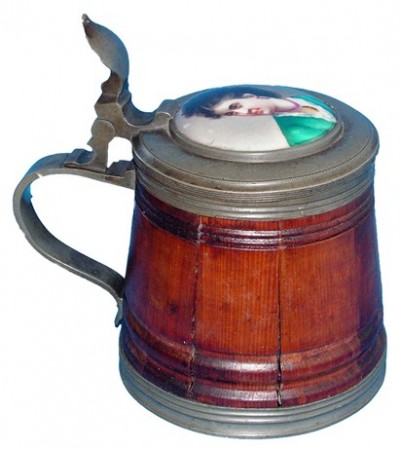
A nicely done Austrian [?] stave tankard with no bands. I can’t tell if it ever had some but I would think so. The pewter is marked “Sammer” (who is not recorded anywhere else.)
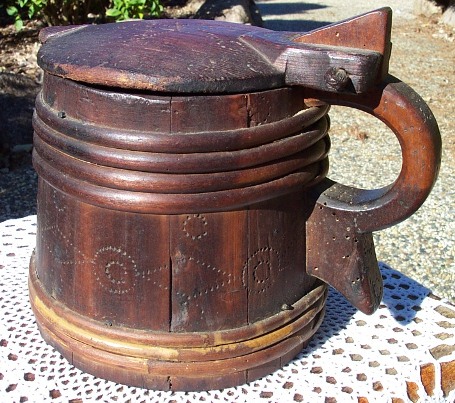
▲ Most probably a “Baltic States” type of vessel, and not Scandinavian. Notice the punched in decor and the way the simple handle and thumblift finial is made. This one obviously has had a re-banding job on the bottom bands. About 8 inches tall to lid. Ca. 1850.
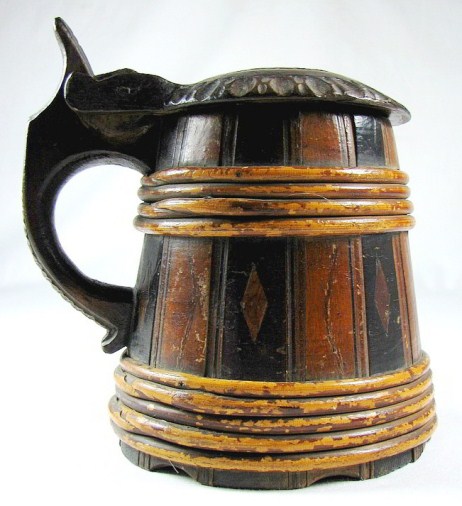
A Baltic States stein – Both staved and inlaid, with a chip-carved lid. Stein comes with a pitched inside. Only 6.25 inches tall to the top of thumblift, so made for a female perhaps? [FWTD]
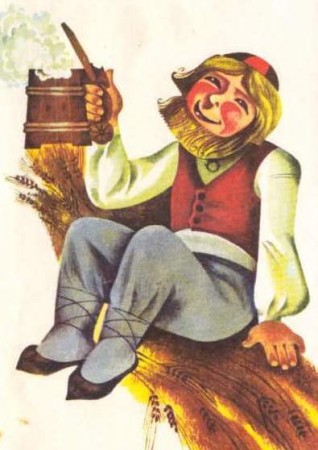
ESTONIAN WOODEN STEIN ON A POST CARD.
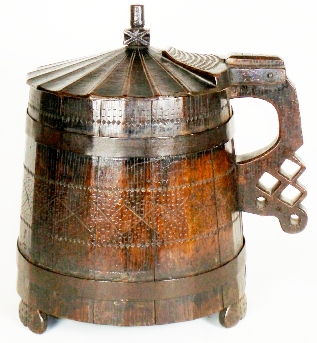
Above: A very well made wooden stein from the “Baltic States”, most likely Estonia. Well over ten inches tall. Circa 1790 – 1840. This is the type US stein auctioneers continue to call “Norwegian”, even though the body and handle design are radically different.
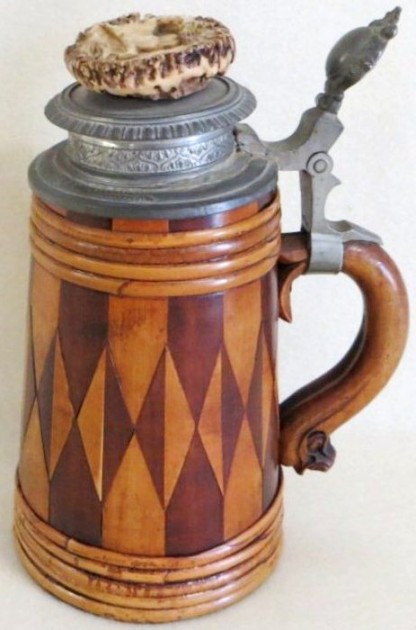
Given the condition of the quality pewter lid and the carved deer bone roundel attached to it, I think this very well kept stein (dated 1902) and from about and made in, close to, if not, Austria. Notice the handle’s carved finial. A very nice wooden stein to own. I wish it was in the “FWTD” collection.
. 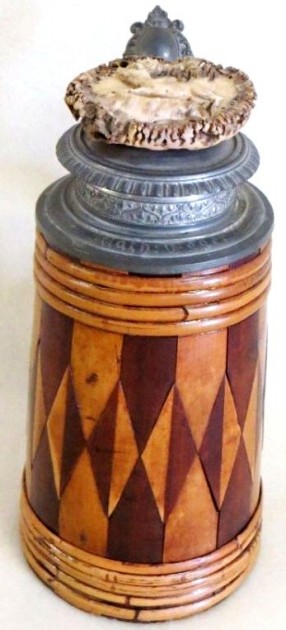 .
.
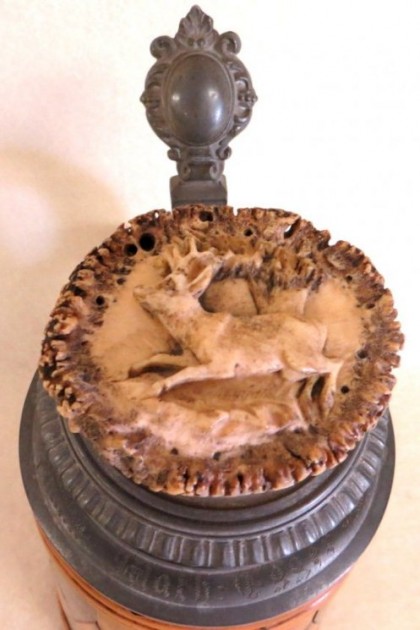
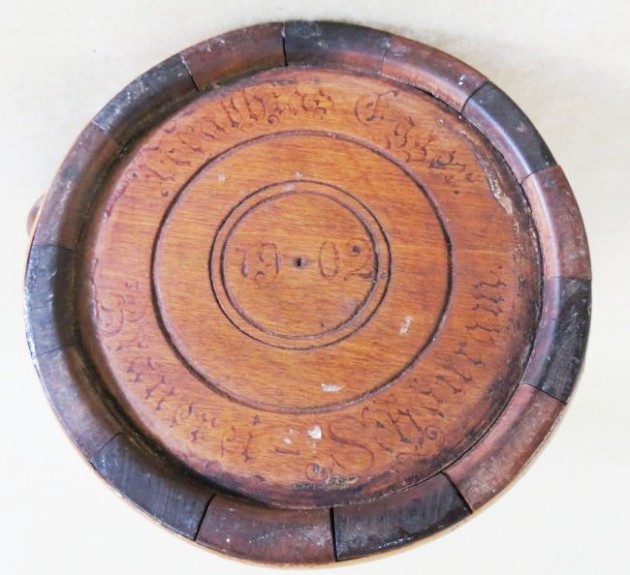
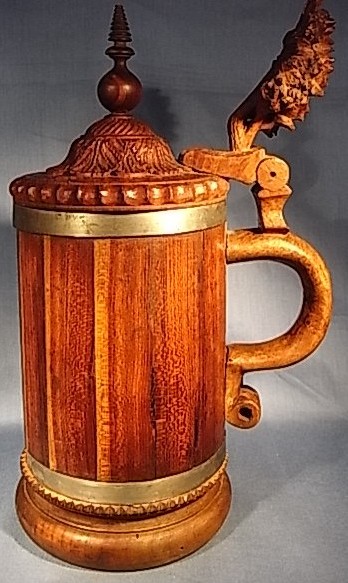
Another somewhat newer wooden stein. 11 inches tall. A very nicely finished example showing that not all newer pieces are P/ O/ S. Circa 1940 I believe, and used. The inside was coated for use but is now somewhat rough.
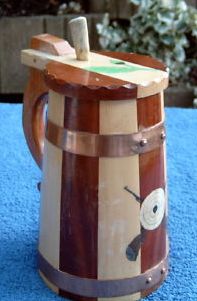
A very new staved tankard made to be a shooting prize. I am not certain it won any design awards. Austrian probably.
CHARACTER BEER STEINS IN WOOD ▼ ▼ [MOST VERY SCARCE ]
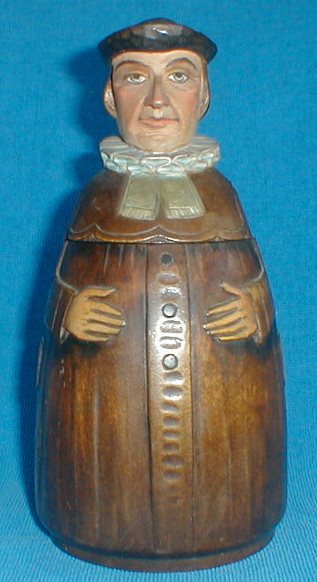
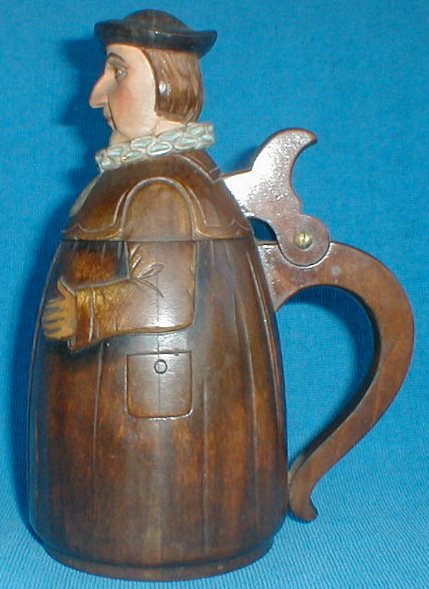
[WB]

Character stein of nobleman. German. Ca. 1880 based only on wear, as the stein is unsigned and possibly unique. A very nice piece appealing to both wooden and character stein collectors. ▲ Detail showing the craftsmanship of the artist that made this one. [ALL 3 WB]
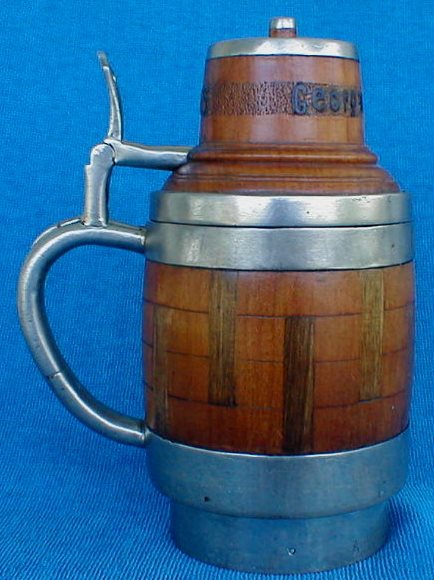
Another interesting and possibly unique stein in WB’s collection. .5 liter and dated 1905.
.
This is a wheel makers occupational stein. It is only obvious when one sees the wagon wheel on the lid. ▼
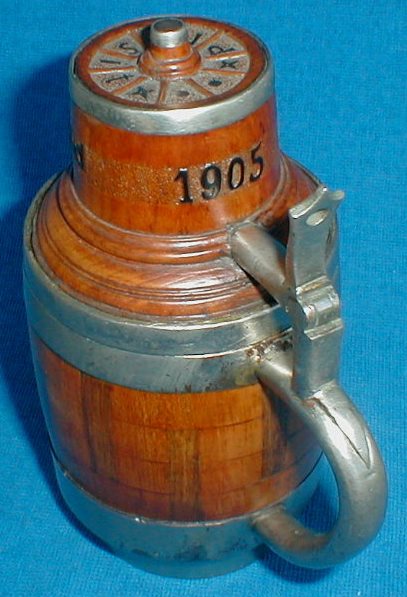
▼ Hand crafted from one piece of wood, this bird is only 8 inches tall [FWTD] The Description posted on the web when this was sold: “Owl with real glass eyes, lined inside with pitch Approx . 205mm high and approx . 115mm diameter on base. Some signs of age and usage are visible. Wood has no cracks or heavy damage . He has received the pitcher many years ago (before 1945) of a war buddy . According to its description, it is the pitcher from Silesia and was probably made in the 1910s. The pitcher stood for many years in his office in a showcase.”
Most probably a memento from the First World War.
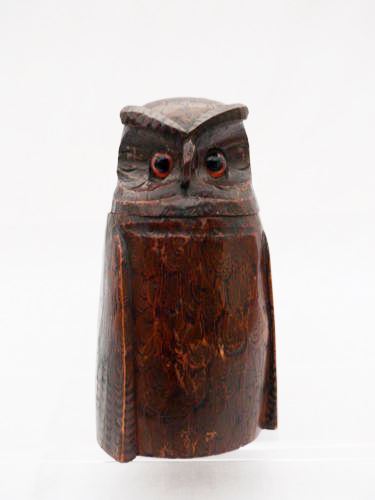
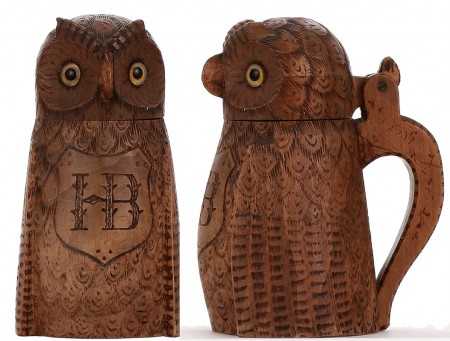
There are many Character steins found in carved wood also. [tsaco]
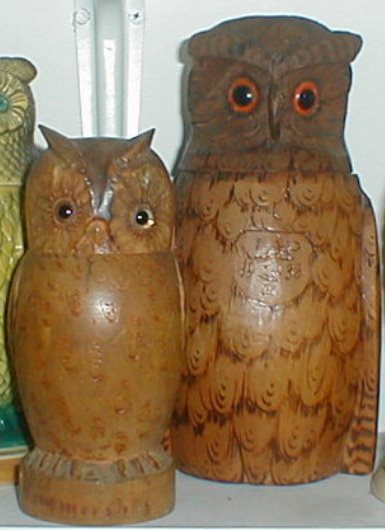
A pair of wooden owl steins. The only real problem with carved wooden character steins is that unless signed and recorded where it was originally made;,it is too hard to tell just by looking at them. What I am saying is that I don’t have a clue where these two came from, nor does the owner, [Comps of W.B,]
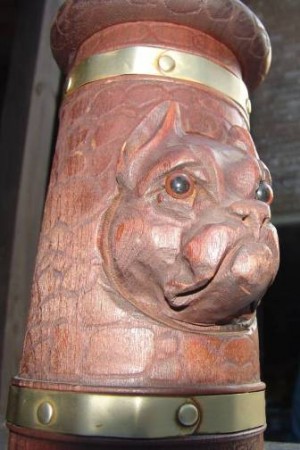
This had to be carved from a large piece of wood. This bull dog was not done separately and then attached to the body. The metal bands are similar to some of the beaked steins, so it is assumed [by me] to be German / Bavarian made.
TURNED AND CARVED WOODEN BEER STEINS ▼ ▼
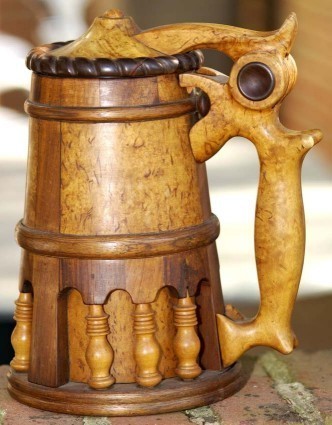
A machined, wheel turned stein of various woods. 9 inches tall and probably made in one of the Baltic States (although this location is a SWAG due to the handle being “somewhat close” to some newer Estonian pieces as I have only seen one other one anything like it! Circa 1910 -30, (which is based on the visible outside wear and a very slight lid warp.) [FWTD]
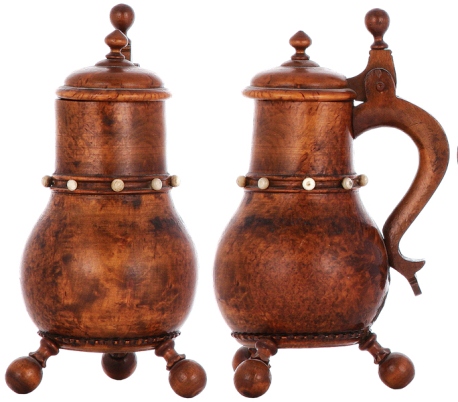
Scandinavian burl wood stein, 7.5′ ht., c.1800, three ball feet, unusual and costly. [TSACO]
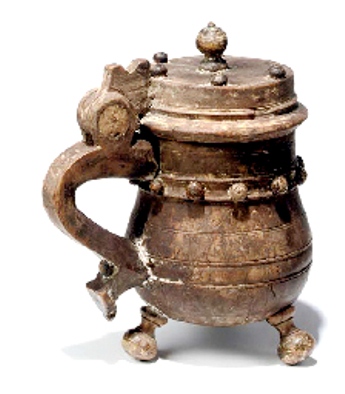
Norwegian or Swedish Birch wood tankard. Dated 1666 . .25 in. (15.8cm.) high. [Christies]
A nicely carved example. Probably Norway or Sweden (given the feet)! Circa late 1700’s – early 1800’s. The figures in the niches are unknown at this time.
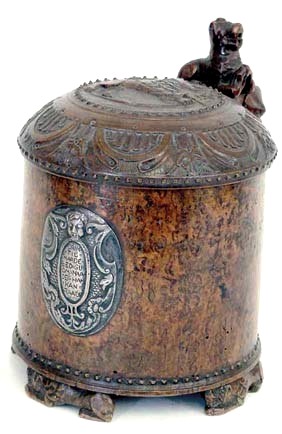
Scandinavian, probably Norway. Silver mounted cartouche. Dated 1732.
.
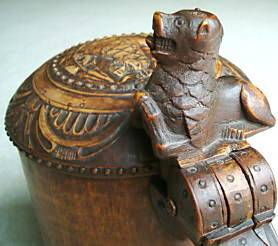
Detail of above’s thumblift and small cut ring designs on the hinge.
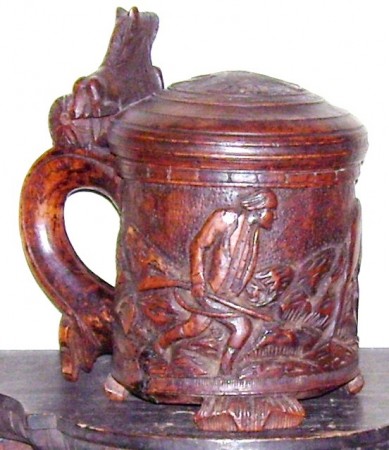 .
.
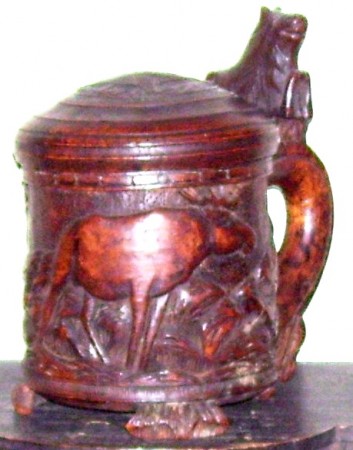
Views of a heavily carved Scandinavian beer stein. Circa. 1750. These carved ones are much harder to find than the plain sided ones, which it appears everyone liked back then, due to the inexpensive way of making them and that those were typically valued wedding presents. . [FWTD]
![1WOODEN STEIN - SCANDINAVIAN [I] - BURL WOOD 8 INCH TALL- BOUGHT AFTER EBAY $375 1600's - 10-29-05](http://www.steveonsteins.com/wp-content/uploads/2010/06/1WOODEN-STEIN-SCANDINAVIAN-I-BURL-WOOD-8-INCH-TALL-BOUGHT-AFTER-EBAY-375-1600s-10-29-05.jpg)
![1WOODEN STEIN - SCANDINAVIAN [I] - BURL WOOD 8 INCH TALL - COST ME $375. -1600-1700'S LID - CLOSE UP](http://www.steveonsteins.com/wp-content/uploads/2010/06/1WOODEN-STEIN-SCANDINAVIAN-I-BURL-WOOD-8-INCH-TALL-COST-ME-375.-1600-1700S-LID-CLOSE-UP.jpg)
A turned, true “burl wood”, Scandinavian stein. Massive and well used. Circa 1670- 1700.[FWTD]
Now for a quick break; here are some interesting (to me at least) wooden beer “mugs.”
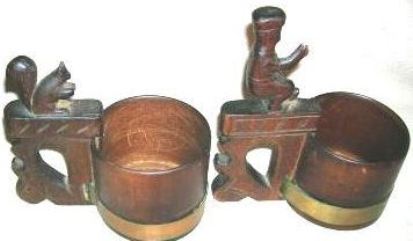
A pair of “folk” carved beer mug about 6 to 8 inches tall at the character thumb-holder. Slovakian. Circa 1850. [FWTD] These older ones are very collectable in Europe.
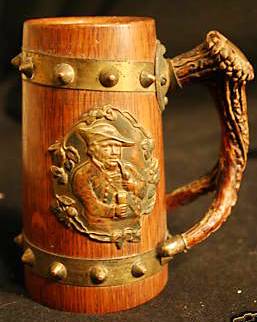
There are several of these mugs to be found in a series. The most common say “Gambrinus and Bacchus” on a small brass cartouche. The antlers by the way are faux (fake) and are all the same on both the one and two handled mugs to be found by this maker. And it is not unusual to find one or two of the small brass knobs missing and the applied color coming off the horns .
For two more of these see: http://www.steveonsteins.com/a-few-unusual-beer-mugs-puzzle-mugs-and-novelties
Scandinavian = Remember, they didn’t all come from Norway folks!

Hand carved drinking bowl brightly colored and given as presents mostly. These bowls occur throughout Scandinavia.
.

A much larger and personalized carved and painted bowl
.
The paonted inside of the bowl just above.
A drinking bowl (KASA) of brightly painted wood. A Scandinavian favorite. Hand carved out of one piece of seasoned wood and shaped like the old Norse ships with either a horse’s, dragon, or bird’s head as one of the handles. They usually have sayings in paint around the top. Shown: Drinking bowl from The Norwegian Museum, no date given but I would say late 1700’s.
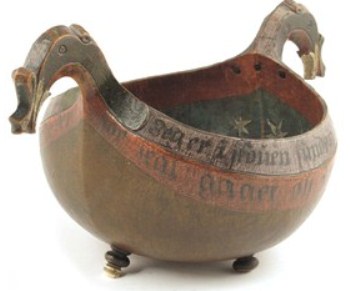
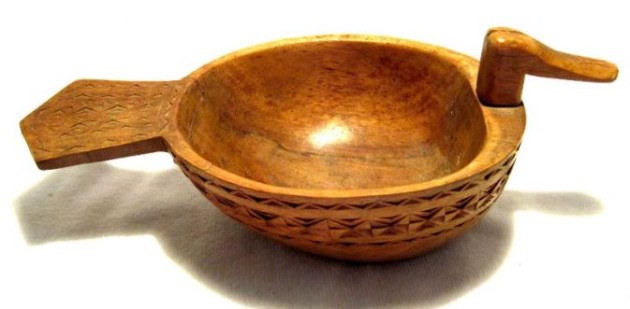 .
.
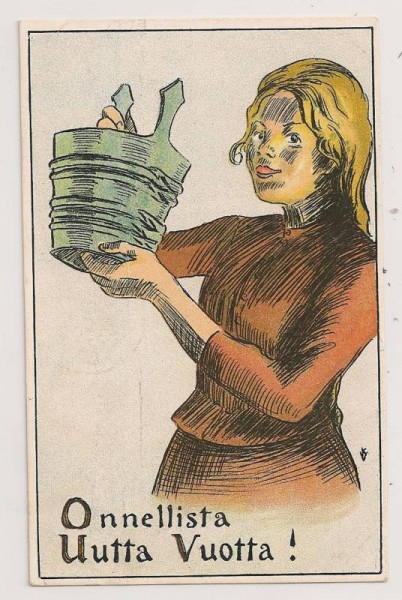
Another type of “drinking bowl.” I have yet to find one of these in 90 to 100% condition.
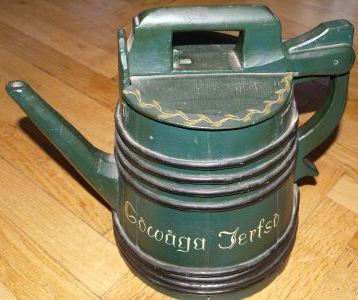 A Swedish ‘Pipstanka,’ used to serve beer / liquids from. Circa mid 1800’s. It is missing the wooden slide on the lid to make the lid secure. See photo, two below.
A Swedish ‘Pipstanka,’ used to serve beer / liquids from. Circa mid 1800’s. It is missing the wooden slide on the lid to make the lid secure. See photo, two below. 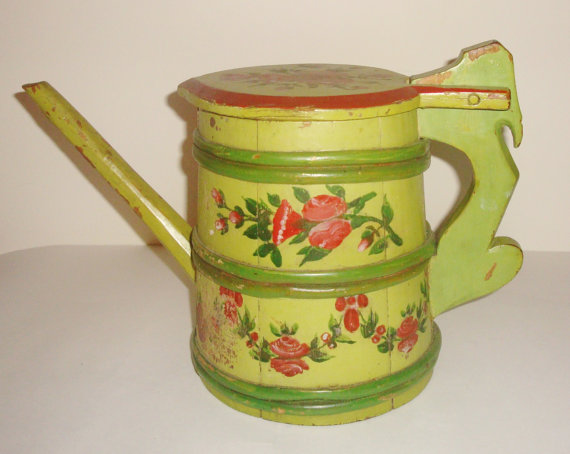 Another Swedish ‘Pipstanka’, a bit newer, say 1910-30. It was called a watering can on the net. .
Another Swedish ‘Pipstanka’, a bit newer, say 1910-30. It was called a watering can on the net. . 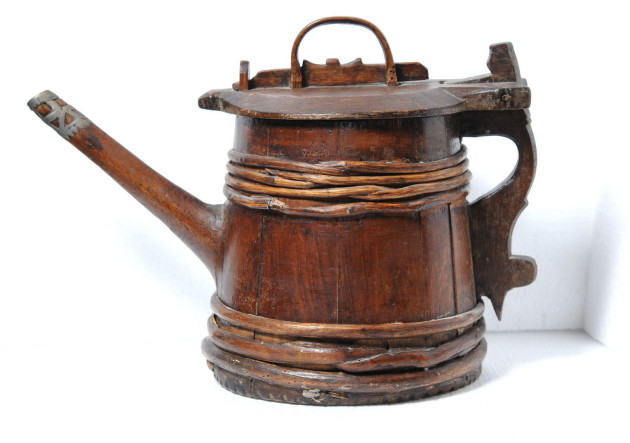 Another but older version with the sliding locking mechanism for the lid, a feature sometimes found on old pewter cans with spouts.
Another but older version with the sliding locking mechanism for the lid, a feature sometimes found on old pewter cans with spouts. 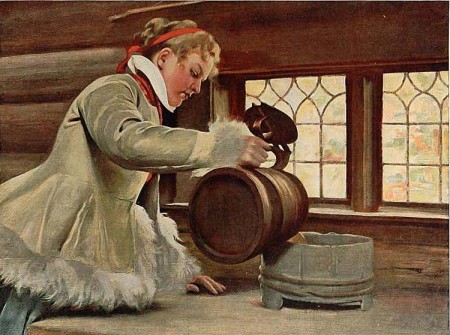 A print showing the locking mechanism on the lid, but this one is without a spout
A print showing the locking mechanism on the lid, but this one is without a spout
Now back to the beer steins and servers: Some nicely carved ones.
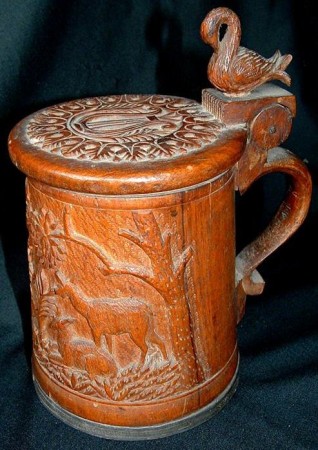
A super little .5 liter carved stein acquired from the auction held at the Schloss (Castle) Marienburgin late in 2005. Obviously custom made for a musician associated with the castle in Hildesheim, a city in lower Saxony. Circa 1860 m.[FWTD]
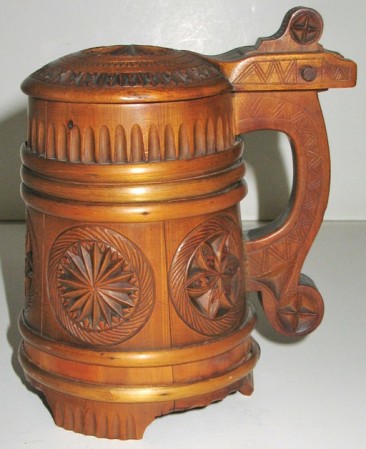
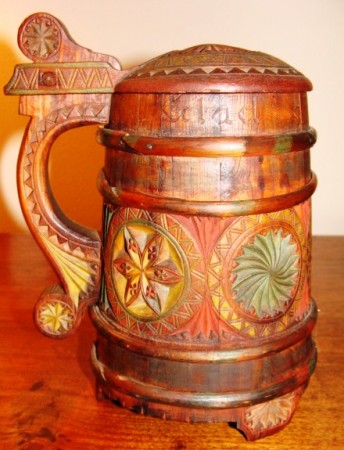
[L] A mildly chipped carved stein, probably Sweden. Circa 1890 -1910. The middle bottom band is missing [FWTD]
[R] Essentially the same stein as shown on the left, only painted and a bit earlier I believe or just with a bit more wear and losses, same bottom band missing [J. Stuart]
.
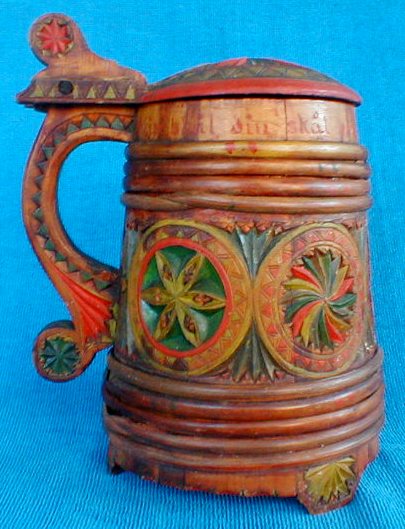
The carved out designs on these steins, which are probably all from the same shop, are as one can see standard. The differences are only in coloration and the number of bands used, based on the body size. This is a rather well kept and pretty example. [WB]
.
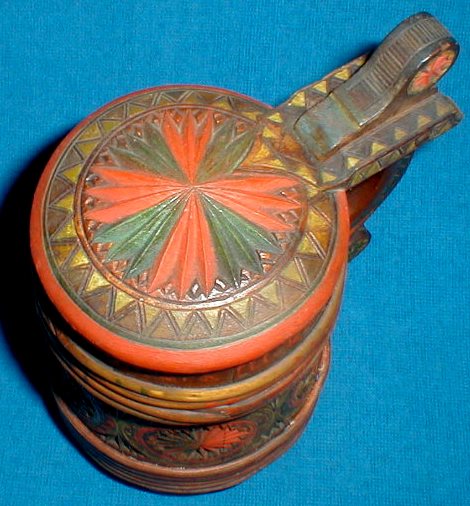
UNUSUAL DESIGNS:
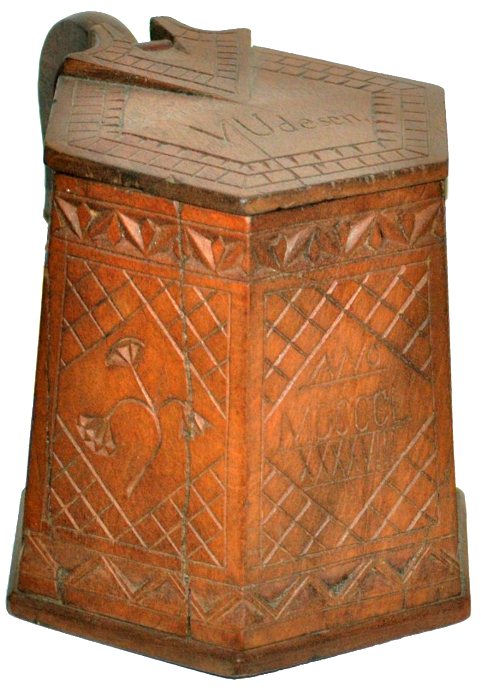 A very unusual six sided /5 liter stein. Unknown which European area. CA. MY SWAG IS: 1870 – 90.
A very unusual six sided /5 liter stein. Unknown which European area. CA. MY SWAG IS: 1870 – 90. 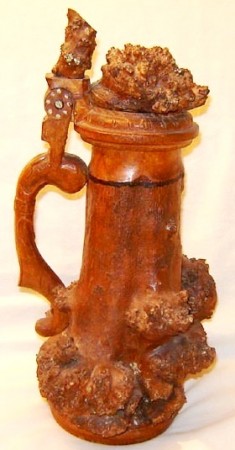 Another tree part. Made from a large knot. Circa 1900. Unknown country of origin. These are very “interesting” as each one is of course different.
Another tree part. Made from a large knot. Circa 1900. Unknown country of origin. These are very “interesting” as each one is of course different. ![1C STAVES ARE CARVED NEAT WOODEN STEIN BALTIC STATES - RUSSIAN [Q] SEE DESIGNS](http://www.steveonsteins.com/wp-content/uploads/2010/06/1C-STAVES-ARE-CARVED-NEAT-WOODEN-STEIN-BALTIC-STATES-RUSSIAN-Q-SEE-DESIGNS-299x450.jpg) An interesting treatment. This is entirely out of one piece of wood as there are no staves! “Baltic states style” but most likely ‘new ‘ and made here in the USA by computer run tools. Circa 2000?
An interesting treatment. This is entirely out of one piece of wood as there are no staves! “Baltic states style” but most likely ‘new ‘ and made here in the USA by computer run tools. Circa 2000? 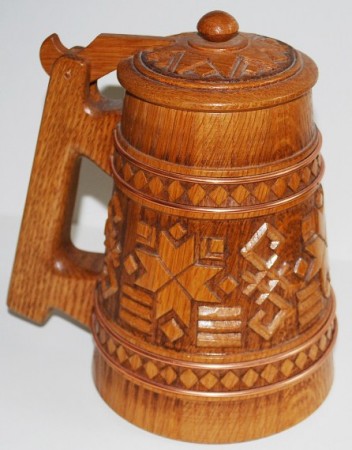 Latvian style beer stein. – New. Oak and hand carved by V.Gredzens (Minneapolis, USA .) Very similar to above, especially the handle .
Latvian style beer stein. – New. Oak and hand carved by V.Gredzens (Minneapolis, USA .) Very similar to above, especially the handle . 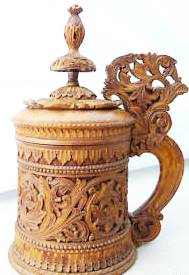 A very nice “chip-carved” stein from Sweden. Circa 1850 -70. These are highly collectable as well they should be as lots of work went into making these.
A very nice “chip-carved” stein from Sweden. Circa 1850 -70. These are highly collectable as well they should be as lots of work went into making these.
Another elaborate “chipped carved” Scandinavian stein. I think about 1800-30. 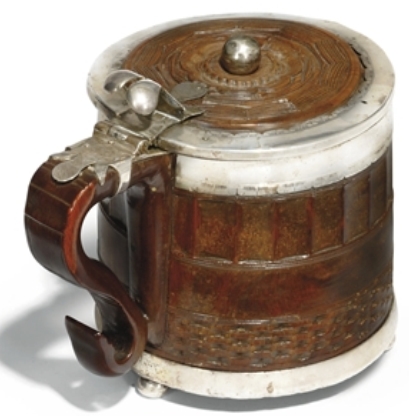
Silver mounted, made of “lignum vitae”
Unmarked but probably English provincial. Mid 17th century (?) [Photo compliments of CHRISTIES auction house.]
Baltic States: Carved floral design with alternating staining on a staved wooden beer stein. Much harder to do than just regular old flat staves. Estonian. Circa: late 1700’s. Has a very distinctive handle and lower handle finial.[FWTD]
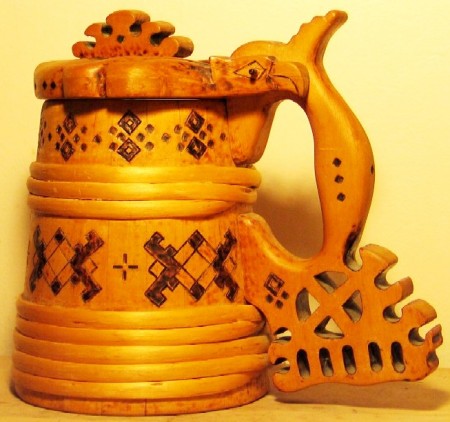
A much newer version, Circa 1920 – 40. With the distinctive carved handle’s bottom finial of an Estonian or very close by piece.
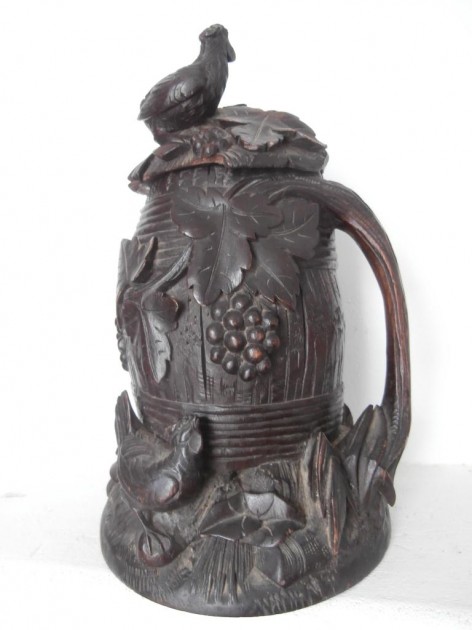
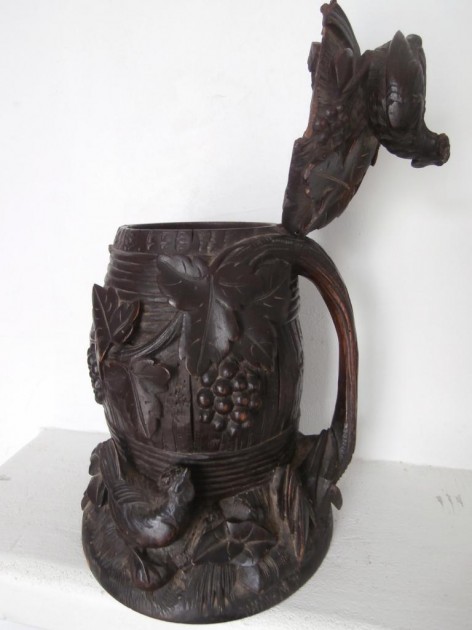
A very well done 12 in.tall Swiss carved stein. Ca. 1860-80 (Not made in the Black Forest, even though they are called that.)
This piece has suffered moderate damage and cracking to the base. Seller was asking just over 300 € (on 5-13.) Still very well done and scarce: about a 6.5 on the Rarity Scale.
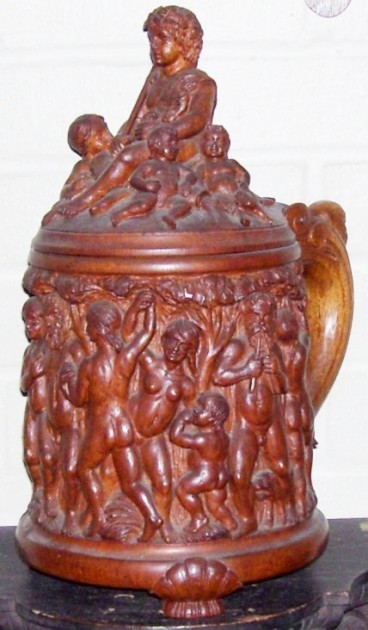
A 13 inch tall fruit wood carved relief stein. Bacchanalian scene, probably of Mediterranean origin (Italian?) Circa 1800 – 1840. [FWTD]
MUCHO DINERO STEINOS !! ▼ ▼ ▼
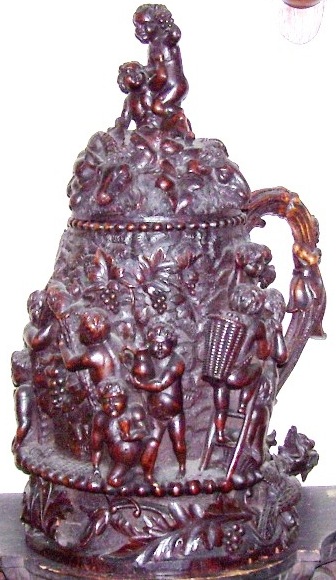 “Gathering of the hops.” One of the premier wooden steins in my collection. About 16 inches tall. This piece is carved a well as any Ivory beer stein I have ever seen! (Even those “professionally cleaned” ones, now located in Eastern Pennsylvania, that now look like plastic!) Circa 1750 – 1800, and it comes with a set-on-lid and some very “minor” losses, which are easy to be forgiven. [FWTD]
“Gathering of the hops.” One of the premier wooden steins in my collection. About 16 inches tall. This piece is carved a well as any Ivory beer stein I have ever seen! (Even those “professionally cleaned” ones, now located in Eastern Pennsylvania, that now look like plastic!) Circa 1750 – 1800, and it comes with a set-on-lid and some very “minor” losses, which are easy to be forgiven. [FWTD]
![1C WOODEN STEIN - SCANDINAVIAN [E] -norwegian birch tankard ca. 1700](http://www.steveonsteins.com/wp-content/uploads/2010/06/1C-WOODEN-STEIN-SCANDINAVIAN-E-norwegian-birch-tankard-ca.-1700.jpg)
Scandinavian, probably Norway, but perhaps Danish. Circa 1650- 1700. When they get to be this old and this ornate, they are very, very scarce and very, very expensive!
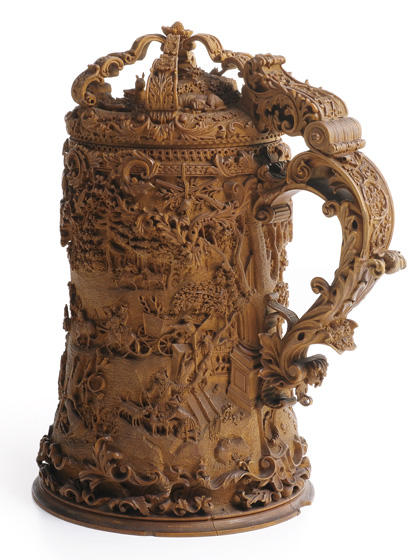
From Nagels auction in Germany 10-12. “An important boxwood hunting tankard by Johann Rint (Kukus.” Some work, and lot of cash to own!
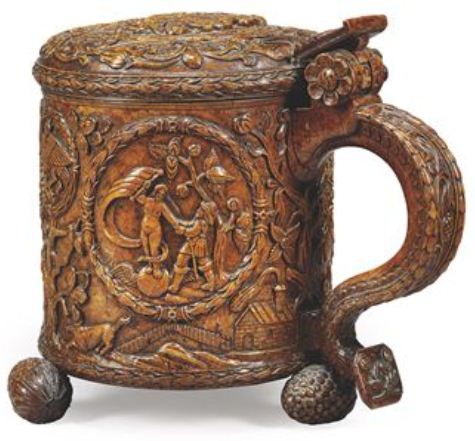
A Norwegian burl peg tankard fom the workshop of Samuel Halvorsen Fanden. Dated 1693 (Sold for only $58,365!) [Photo comps of Christies.]

Another “little” carved jewel from Scandinavia – for sale in a London showroom in March 2014 for again about $50,000 .00. But well worth it I think !
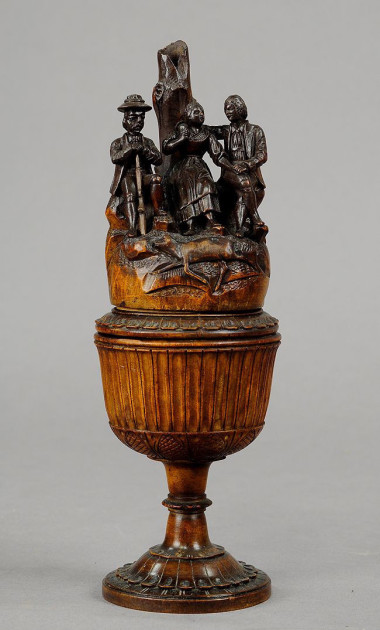 Hand carved small pokal (cup and cover) not a stein but I think worthy of the posting on this page.
Hand carved small pokal (cup and cover) not a stein but I think worthy of the posting on this page. 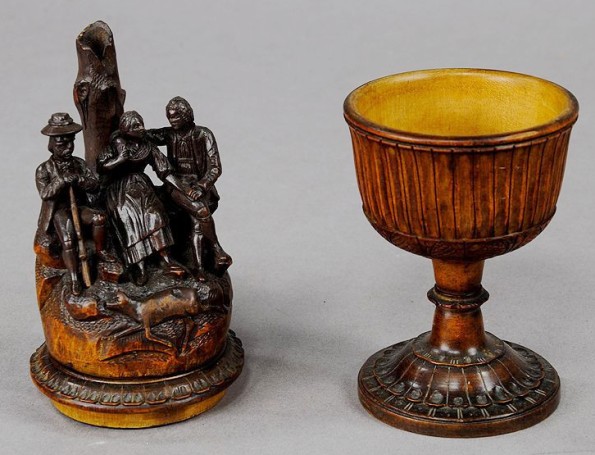 [FWTD] ~AQUIRED IN FALL OF 2014
[FWTD] ~AQUIRED IN FALL OF 2014
Please go to page two.
[END – PAGE ONE – SOP104 – 89 – R5]  “With sufficient thrust, pigs will fly just fine.”
“With sufficient thrust, pigs will fly just fine.”

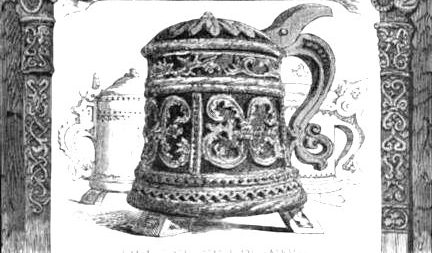
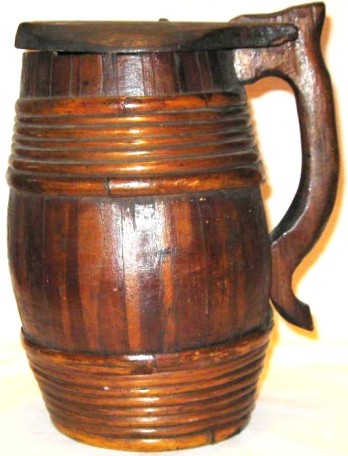
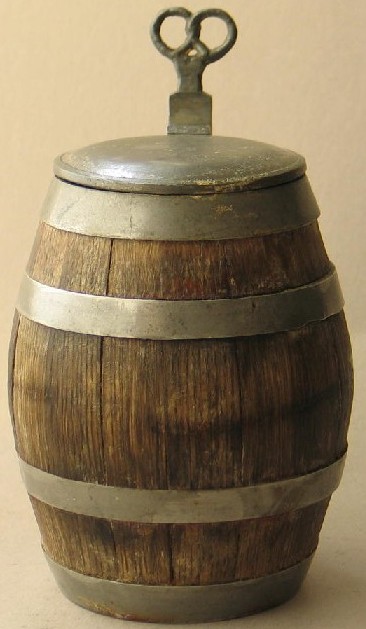
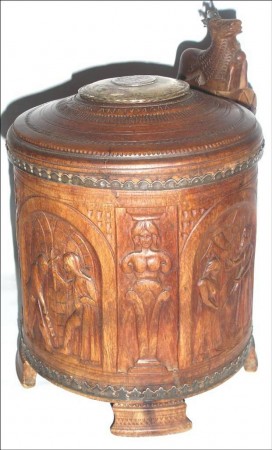
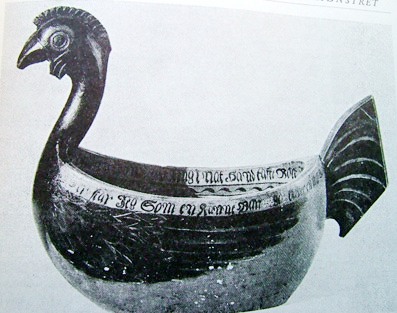
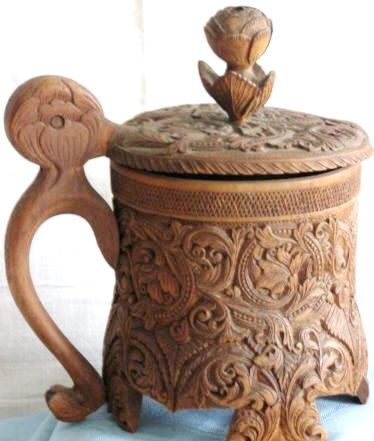
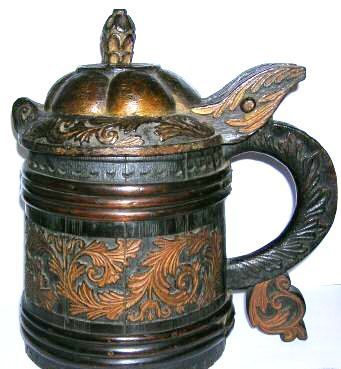
Leave a Reply